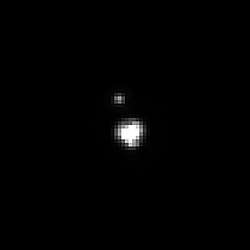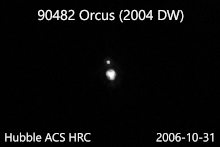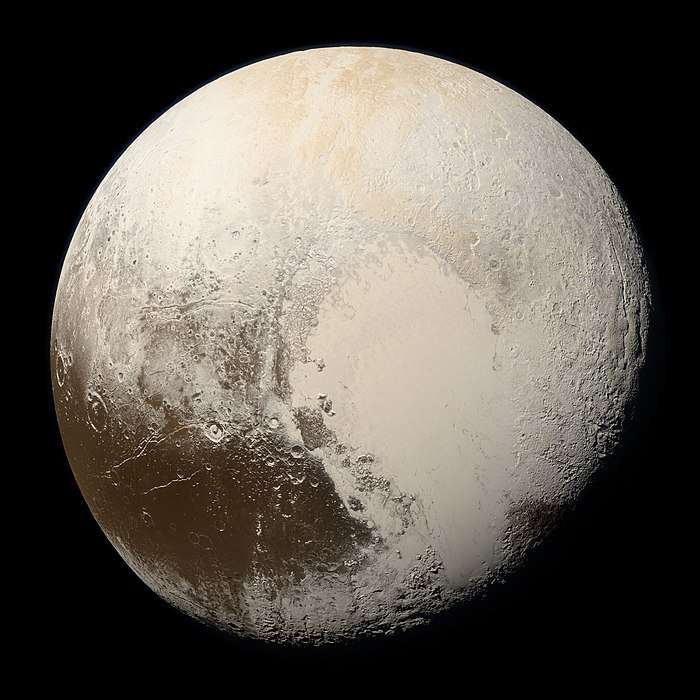Vanth (moon)
Vanth, full designation (90482) Orcus I Vanth, is the single known natural satellite of the plutino and likely dwarf planet Orcus. With a diameter of about 440 km, it is probably the third-largest known moon of a Trans-Neptunian object, after Pluto I Charon and Eris I Dysnomia, though it is possible that the poorly resolved Varda I Ilmarë or Haumea I Hiʻiaka might be comparable in size. Vanth was discovered by Michael Brown and T.-A. Suer using discovery images taken by the Hubble Space Telescope on 13 November 2005.[1] The discovery was announced in an IAU Circular notice published on 22 February 2007.[2]
 Discovery image of Vanth by the Hubble Space Telescope in November 2005 | |
| Discovery | |
|---|---|
| Discovered by | Michael E. Brown T.-A. Suer |
| Discovery date | 13 November 2005 [lower-alpha 1] |
| Designations | |
Designation | Orcus I |
| Pronunciation | /ˈvænθ/ |
| S/2005 (90482) 1 | |
| Adjectives | Vanthian |
| Orbital characteristics[3] | |
| 8999.8±9.1 km | |
| Eccentricity | 0.00091±0.00053 km |
| 9.539154±0.00002 d | |
| Inclination | 105.03±0.18° |
| Satellite of | Orcus |
| Physical characteristics | |
| Dimensions | 442.5±10.2 km[4] 475±75 km[5] |
| Mass | (3.6–6.8)×1019 kg[lower-alpha 2] |
Mean density | ≈ 0.8–1.5 g/cm3[4] |
| synchronous[6] | |
| Albedo | ≈ 0.12[7] 0.08+0.02 −0.01[5] |
Spectral type | moderately red (optical)[8] |
| 21.97 ± 0.05[8] | |
| 4.88 ± 0.05[8] | |
Using observations with the Hubble Space Telescope from 13 November 2005, Michael Brown and T. A. Suer detected a natural satellite.[1] The discovery of a satellite of Orcus was reported in an IAU Circular notice published on 22 February 2007.[2] The satellite was given the designation S/2005 (90482) 1 before later being named Vanth. It orbits Orcus in a nearly face-on circular orbit with an eccentricity of about 0.007, and an orbital period of 9.54 days.[8] Vanth orbits only 9,030 km (5,610 mi) from Orcus and is too close to Orcus for ground-based spectroscopy to determine the surface composition of the satellite.[7]
Brown suspects that like the Pluto–Charon system, Orcus and Vanth are tidally locked.[9] Vanth does not resemble known collisional satellites because its spectrum is very different from that of its primary, and it may be a captured Kuiper belt object.[9] Vanth could also have originated as a result of rotational fission of the primordial Orcus, which would have rotated much faster than now.[6]
Name
Upon discovery, Vanth was issued a provisional designation, S/2005 (90482) 1. On 23 March 2009, Brown asked readers of his weekly column to suggest possible names for the satellite, with the best one to be submitted to the International Astronomical Union (IAU) on 5 April.[9] The name Vanth, the winged Etruscan psychopomp who guides the souls of the dead to the underworld, was chosen from among a large pool of submissions. Vanth was the only suggestion that was purely Etruscan in origin. It was the most popular submission, first suggested by Sonya Taaffe.[10] This submission was assessed and approved by the IAU's Committee for Small Body Nomenclature, in accordance with the naming procedures for minor planets and satellites.[11][12] The official naming citation was announced in a Minor Planet Circular notice published on 30 March 2010.[13]
The Etruscan Vanth is frequently portrayed in the company of Charun (Charon), and so as the name of the moon of Orcus (nicknamed the "anti-Pluto" because resonance with Neptune keeps it on the opposite side of the Sun from Pluto), it is an allusion to the parallels between Orcus and Pluto. Brown quoted Taaffe as saying that if Vanth "accompanies dead souls from the moment of death to the underworld itself, then of course her face is turned always toward Orcus", a reference to the likely synchronous orbit of Vanth about Orcus.[10]
Characteristics



Vanth was found at 0.25 arcseconds from Orcus with magnitude difference of 2.7±1.0.[1] Estimates made in 2009 by Brown show that the apparent magnitude of Vanth is 21.97±0.05 which is 2.54±0.01 magnitudes fainter than Orcus.[8] Assuming equal albedos this would mean a diameter of 280 km (170 mi), or 2.9 times smaller than the primary.[7] However, the dissimilar colors of Orcus (neutral) and Vanth (red) suggest that Vanth could have an albedo a factor of two lower than Orcus.[8] Should Vanth have an albedo of only 0.12, Vanth could be as large as 380 km (240 mi) with Orcus being 760 km (470 mi) in diameter.[7] The mass of Vanth also depends on its albedo and can vary from 3 to 9 percent of the total system mass.[7][8] In 2016, Brown and Butler used resolved ALMA images and estimated Vanth's diameter at 480 km (300 mi), about half Orcus's diameter, making Orcus and Vanth a smaller analog of Pluto and Charon.[5] They also measured Vanth's albedo as only 0.08+0.02
−0.01, almost 3 times darker than Orcus.
For 7 March 2017, a stellar occultation by Orcus had been predicted to take place in the Americas and over the Pacific Ocean. Observations were made at five sites in North and South America, and two solid body chords have been observed. Using speckle imaging, the occulted star was revealed to be a close double star, and a reconstruction of the orbits of Orcus and Vanth showed that both chords were from Vanth (occulting either of the two stars) rather than Orcus. A non-detection at a nearby site placed a constraint of 442.5±10.2 km (274.9±6.3 km) on the diameter of Vanth. The occultation data is consistent with a pressure of at most 4 microbar for a global atmosphere of Vanth.[4]
Vanth does not resemble other known collisional satellites because its spectrum is very different from that of its primary. Vanth may thus be a captured Kuiper belt object.[9] In that respect, it may be similar to the satellite of another possible dwarf planet, Gonggong, which also has a very different colour compared to its primary.[14]
Notes
- Discovery announced on 22 February 2007.[1][2]
- Calculated with the diameter of 442.5 km (radius 221.25 km) and assumed density of 0.8–1.5 g/cm3.[4] Assuming a spherical shape for Vanth, the radius of 221.25 km yields a volume of approximately 3.504×107 km3. Multiplying the volume with the densities of 0.8 g/cm3 or 1.5 g/cm3 yields the approximate masses of 3.6×1019 kg and 6.8×1019 kg.
References
- Daniel W. E. Green (22 February 2007). "IAUC 8812: Sats OF 2003 AZ_84, (50000), (55637),, (90482)". International Astronomical Union Circular. Retrieved 4 July 2011.
- Wm. Robert Johnston (4 March 2007). "(90482) Orcus". Johnston's Archive. Archived from the original on 10 February 2009. Retrieved 26 March 2009.
- Grundy, W. M.; Noll, K. S.; Roe, H. G.; Buie, M. W.; Porter, S. B.; Parker, A. H.; Nesvorný, D.; Benecchi, S. D.; Stephens, D. C.; Trujillo, C. A. (2019). "Mutual Orbit Orientations of Transneptunian Binaries" (PDF). Icarus. doi:10.1016/j.icarus.2019.03.035. ISSN 0019-1035.
- Sickafoose, A. A.; Bosh, A. S.; Levine, S. E.; Zuluaga, C. A.; Genade, A.; Schindler, K.; Lister, T. A.; Person, M. J. (February 2019). "A stellar occultation by Vanth, a satellite of (90482) Orcus". Icarus. 319: 657–668. arXiv:1810.08977. Bibcode:2019Icar..319..657S. doi:10.1016/j.icarus.2018.10.016.
- Brown, Michael E.; Butler, Bryan J. (22 January 2018). "Medium-sized satellites of large Kuiper belt objects". The Astronomical Journal. 156 (4): 164. arXiv:1801.07221. doi:10.3847/1538-3881/aad9f2.
- Ortiz, J. L.; Cikota, A.; Cikota, S.; Hestroffer, D.; Thirouin, A.; Morales, N.; Duffard, R.; Gil-Hutton, R.; Santos-Sanz, P.; De La Cueva, I. (2010). "A mid-term astrometric and photometric study of trans-Neptunian object (90482) Orcus". Astronomy & Astrophysics. 525: A31. arXiv:1010.6187. Bibcode:2011A&A...525A..31O. doi:10.1051/0004-6361/201015309.
- Carry, B.; Hestroffer, D.; Demeo, F. E.; Thirouin, A.; Berthier, J.; Lacerda, P.; Sicardy, B.; Doressoundiram, A.; Dumas, C.; Farrelly, D.; Müller, T. G. (2011). "Integral-field spectroscopy of (90482) Orcus-Vanth". Astronomy & Astrophysics. 534: A115. arXiv:1108.5963. Bibcode:2011A&A...534A.115C. doi:10.1051/0004-6361/201117486.
- Brown, M.E.; Ragozzine, D.; Stansberry, J.; Fraser, W.C. (2010). "The size, density, and formation of the Orcus-Vanth system in the Kuiper belt". The Astronomical Journal. 139 (6): 2700–2705. arXiv:0910.4784. Bibcode:2010AJ....139.2700B. doi:10.1088/0004-6256/139/6/2700.
- Michael E. Brown (23 March 2009). "S/2005 (90482) 1 needs your help". Mike Brown's Planets (blog). Archived from the original on 28 March 2009. Retrieved 25 March 2009.
- Michael E. Brown (6 April 2009). "Orcus Porcus". Mike Brown's Planets (blog). Archived from the original on 14 April 2009. Retrieved 6 April 2009.
- "Committee on Small Body Nomenclature: Names of Minor Planets". Retrieved 8 April 2009.
- "The MINOR PLANET CIRCULARS/MINOR PLANETS AND COMETS" (PDF). Minorplanetcenter.org. 30 March 2010. Retrieved 12 October 2017.
- "Minor planet circular" (PDF). minorplanetcenter.org. 2010. Retrieved 8 August 2010.
- Kiss, C.; Marton, G.; Parker, A.; Grundy, W.; Farkas-Takács, A. I.; Stansberry, J.; Pal, A.; Müller, T. G.; Noll, K.; Schwamb, M. E.; Barr Mlinar, A. C.; Young, L. A.; Vinkó, J. (24 October 2018). The mass and density of the dwarf planet 2007 OR10. 50th annual meeting of the AAS Division of Planetary Sciences. abstract 311.02. Retrieved 21 September 2018.
_(cropped).jpg)
